Analyzing the Effects of Nano-Titanium Dioxide and Nano-Zinc Oxide Nanoparticles on the Mechanical and Durability Properties of Self-Cleaning Concrete
Abstract
:1. Introduction
2. Materials and Methods
2.1. Materials
2.1.1. Cement
2.1.2. Aggregate
2.1.3. Nano-Materials
TiO2 (Titanium Dioxide)
ZnO (Zinc Oxide)
2.1.4. Water
- For fresh tap water: the samples were cast in clean, impurity-free (lacking impurities, such as salts, organic compounds, acids, oils, etc.) fresh tap water, which was also employed in the fresh tap-water-curing series. In accordance with ASTM D 1193 [34], it was also devoid of silt, clay, and other elements that could have harmed the steel-reinforced concrete or other materials. The water used for mixing, nevertheless, had a pH of 7.
- For salt water: water for the series of seawater cures came from Qaroun Lake in Al-Fayoum, Egypt. Table 6 contains a list of this water’s chemical elements.
2.1.5. Super-Plasticizers
2.1.6. Phenolphthalein Solution (Phph Dye)
2.2. Concrete Mix Design
2.2.1. Features of Concrete Mixtures
2.2.2. Preparing Mixes
- First, all the components were weighed: the cement, the dolomite, the sand, and finally the water, including the superplasticizer and nano-materials for the TiO2 and ZnO specimens.
- For the concrete mixes of cubes and cylinders, mixing was performed in the mixer. Firstly, the dry components—dolomite, cement, and sand—were mixed for one minute before adding another ingredient. Then, water was added, including the superplasticizer (with or without nano-materials), and was mixed using a stirrer. The mixing process should take at least two minutes after adding the dry components, and one minute after adding the water.
- For the mortar mixes of prismatic specimens, mixing was performed by hand. Firstly, water and nps-TiO2 or nps-ZnO were mixed together by using a stirrer for a further 5–8 min to provide a uniform distribution. Then, the superplasticizer was added to them during the mixing. Thereafter, cement and sand were introduced. Then, the previous mixture was added to the cement and sand, and they were mixed for a further 5 min to obtain a homogeneous mix.
3. Experimental Plan
3.1. Compressive and Flexural Strengths
3.2. Corrosion Rate
Linear Polarization Resistance (LPR)
3.3. Phenolphthalein Discoloration Test
3.4. Instrumentation
3.4.1. Scanning Electron Microscope (SEM)
3.4.2. Energy Dispersive X-ray Spectroscopy (EDX)
4. Results and Discussion
4.1. Compressive Strength Test
4.2. Flexural Strength
4.3. Corrosion Rate
4.4. Results of Phenolphthalein Discoloration Test
4.5. Microstructure Analysis
5. Conclusions
- In nps-TiO2 and nps-ZnO mixes, the best percentages for compressive strength are TM-2.5% and ZM-1%. However, the optimal ratios for flexural strength are 1% for nps-TiO2 mixtures and 1% for nps-ZnO mixtures. With higher nps-TiO2 concentrations, the nps-TiO2 mixture’s compressive strength increased, with 2.5% of nps-TiO2 being the ideal concentration. As a result, at 7, 28, and 90 days, the increment ratios of the sample containing 2.5% of nps-TiO2 were 23.82%, 22.64%, and 28.54%, respectively.
- As increasing nps-ZnO percentages reduce compressive strength in comparison to ZM-1, the ideal nps-ZnO percentage for samples is 1%. At 28 and 90 days, ZM-1 improved the corresponding strengths by 10.90% and 9.38%, respectively.
- For the flexural strength test, TM-1 (1%), for nps-TiO2, is the ideal value. For this sample, the percentages increased by about 33.46%, 33.33%, and 20% for 7, 28, and 90 days, respectively. Additionally, the findings of this study indicate that the flexural strength of nps-ZnO samples decreases with increasing nps-ZnO ratios. For samples containing 1% nps-ZnO, the percentages rose by 50.29%, 33.33%, and 16% at 7, 28, and 90 days, respectively (this is the ideal ratio for nps-ZnO samples).
- In regard to corrosion rate, this study shows that the corrosion rate for nps-TiO2 specimens gradually reduces with an increasing nps-TiO2 percentage in all exposure conditions. This may happen as a result of increasing the volume of C-S-H gel and reducing the number of pores. However, the results for the nps-ZnO samples indicate that the corrosion rate increases when the nps-ZnO ratio increases more than 1%. Additionally, ZM-1% from the nps-ZnO mixes was the optimum percentage. It is obvious that the samples increasingly self-clean as exposure duration is extended due to photocatalytic deterioration. The findings demonstrate that nps-TiO2 samples perform better overall than nps-ZnO samples.
- According to this study’s findings, all samples display some degree of self-cleaning effectiveness in exposure to UV light or sunlight, even when no nano-materials are present (0%). In general, the self-cleaning effectiveness of the mixtures improves as the TiO2 concentration rises from 0.5% to 2.5%. Although an increase in the quantity of active TiO2 does not considerably speed up the samples’ degradation of RhB, an increase in the TiO2 content is predicted to increase the amount of activated TiO2. Due to titanium dioxide’s photocatalytic activity, the organic material decomposes, which causes the color shift.
- Similar to the photocatalyst of nps-TiO2, nps-ZnO, as a nano-photocatalyst, has significant potential for use as a self-cleaning agent in concrete buildings. According to the results of this study, nps-ZnO has reduced photodegradation efficiency, this may be why it does not perform as well in these interactions. Also, the photocatalytic activity of nps-ZnO may be affected by crystallinity.
Author Contributions
Funding
Data Availability Statement
Conflicts of Interest
References
- Hernández-Rodríguez, M.J.; Santana Rodríguez, R.; Darias, R.; González Díaz, O.; Pérez Luzardo, J.M.; Doña Rodríguez, J.; Pulido Melián, E. Effect of TiO2 addition on mortars: Characterization and photoactivity. Appl. Sci. 2019, 9, 2598. [Google Scholar] [CrossRef]
- Arora, N.K.; Parmar, K.A.; Odedra, R.K. Photocatalytic Self cleaning Concrete. IJSRD—Int. J. Sci. Res. Dev. 2014, 1, 2521–2523. [Google Scholar]
- Fujishima, A.; Honda, K. Electrochemical photolysis of water at a semiconductor electrode. Nature 1972, 238, 37–38. [Google Scholar] [CrossRef]
- Ishchenko, O.M.; Rogé, V.; Lamblin, G.; Lenoble, D. TiO2-and ZnO-based materials for photocatalysis: Material properties, device architecture and emerging concepts. In Semiconductor Photocatalysis-Materials, Mechanisms and Applications; IntechOpen: London, UK, 2016; pp. 3–30. [Google Scholar]
- Zailan, S.N.; Mahmed, N.; Abdullah, M.M.A.B.; Sandu, A.V.; Shahedan, N.F. Review on characterization and mechanical performance of self-cleaning concrete. In Proceedings of the MATEC Web of Conferences, Ho Chi Minh City, Vietnam, 5–6 August 2016; Volume 97, p. 01022. [Google Scholar]
- Bocci, M.; Cerni, G.; Colagrande, S. Experimental investigation of the dynamic behaviour of asphalt concrete treated with photocatalytic mortars. In Proceedings of the 3rd International Conference on Tranportation Infrastructure, Pisa, Italy, 22–25 April 2014; pp. 95–102. [Google Scholar]
- Venturini, L.; Bacchi, M. Research, design, and development of a photocatalytic asphalt pavement. In Proceedings of the 2nd International Conference on Environmentally Friendly Roads: ENVIROAD, Warsaw Poland, 15–16 October 2009. [Google Scholar]
- Han, B.; Ding, S.; Wang, J.; Ou, J. Nano-Engineered Cementitious Composites: Principles and Practices; Springer: Singapore, 2019. [Google Scholar]
- Raki, L.; Beaudoin, J.; Alizadeh, R.; Makar, J.; Sato, T. Cement and concrete nanoscience and nanotechnology. Materials 2010, 3, 918–942. [Google Scholar] [CrossRef]
- Veedu, V.P. Multifunctional Cementitious Nanocomposite Material and Methods of Making the Same. Google Patents US7875211B1, 25 January 2011. [Google Scholar]
- Ochiai, T.; Fujishima, A. Photoelectrochemical properties of TiO2 photocatalyst and its applications for environmental purification. J. Photochem. Photobiol. C Photochem. Rev. 2012, 13, 247–262. [Google Scholar] [CrossRef]
- Si, H.; Zhou, M.; Fang, Y.; He, J.; Yang, L.; Wang, F. Photocatalytic concrete for NOx degradation: Influence factors and durability. Constr. Build. Mater. 2021, 298, 123835. [Google Scholar] [CrossRef]
- Talaiekhozani, A.; Rezania, S.; Kim, K.-H.; Sanaye, R.; Amani, A.M. Recent advances in photocatalytic removal of organic and inorganic pollutants in air. J. Clean. Prod. 2021, 278, 123895. [Google Scholar] [CrossRef]
- Sargam, Y.; Wang, K. Influence of dispersants and dispersion on properties of nanosilica modified cement-based materials. Cem. Concr. Compos. 2021, 118, 103969. [Google Scholar] [CrossRef]
- Mendoza, C.; Valle, A.; Castellote, M.; Bahamonde, A.; Faraldos, M. TiO2 and TiO2–SiO2 coated cement: Comparison of mechanic and photocatalytic properties. Appl. Catal. B Environ. 2015, 178, 155–164. [Google Scholar] [CrossRef]
- Fernandes, C.N.; Ferreira, R.L.; Bernardo, R.D.; Avelino, F.; Bertini, A.A. Using TiO2 nanoparticles as a SO2 catalyst in cement mortars. Constr. Build. Mater. 2020, 257, 119542. [Google Scholar] [CrossRef]
- Wang, J.; Han, B.; Li, Z.; Yu, X.; Dong, X. Effect investigation of nanofillers on CSH gel structure with Si NMR. J. Mater. Civ. Eng. 2019, 31, 04018352. [Google Scholar] [CrossRef]
- Li, Z.; Ding, S.; Yu, X.; Han, B.; Ou, J. Multifunctional cementitious composites modified with nano titanium dioxide: A review. Compos. Part A Appl. Sci. Manuf. 2018, 111, 115–137. [Google Scholar] [CrossRef]
- Pacheco-Torgal, F.; Jalali, S. Nanotechnology: Advantages and drawbacks in the field of construction and building materials. Constr. Build. Mater. 2011, 25, 582–590. [Google Scholar] [CrossRef]
- Deb, P.S.; Sarker, P.K.; Barbhuiya, S. Effects of nano-silica on the strength development of geopolymer cured at room temperature. Constr. Build. Mater. 2015, 101, 675–683. [Google Scholar] [CrossRef]
- Deb, P.S.; Sarker, P.K.; Barbhuiya, S. Sorptivity and acid resistance of ambient-cured geopolymer mortars containing nano-silica. Cem. Concr. Compos. 2016, 72, 235–245. [Google Scholar] [CrossRef]
- Chen, J.; Kou, S.-C.; Poon, C.-S. Hydration and properties of nano-TiO2 blended cement composites. Cem. Concr. Compos. 2012, 34, 642–649. [Google Scholar] [CrossRef]
- Nazari, A.; Riahi, S. The effects of TiO2 nanoparticles on physical, thermal and mechanical properties of concrete using ground granulated blast furnace slag as binder. Mater. Sci. Eng. A 2011, 528, 2085–2092. [Google Scholar] [CrossRef]
- Asadi, S.; Hassan, M.M.; Kevern, J.T.; Rupnow, T.D. Development of photocatalytic pervious concrete pavement for air and storm water improvements. Transp. Res. Rec. 2012, 2290, 161–167. [Google Scholar] [CrossRef]
- Kenanakis, G.; Vernardou, D.; Katsarakis, N. Light-induced self-cleaning properties of ZnO nanowires grown at low temperatures. Appl. Catal. A Gen. 2012, 411, 7–14. [Google Scholar] [CrossRef]
- Khayyat, S.A.; Abaker, M.; Umar, A.; Alkattan, M.O.; Alharbi, N.D.; Baskoutas, S. Synthesis and characterizations of Cd-doped ZnO multipods for environmental remediation application. J. Nanosci. Nanotechnol. 2012, 12, 8453–8458. [Google Scholar] [CrossRef]
- Copeland, L.; Kantro, D.; Verbeck, G. Paper IV–3. Chemistry of Hydration of Portland Cement. In Chemistry of Cement, Proceedings of the Fourth International Symposium, Washington, DC, USA, 2–7 October 1960; National Bureau of Standards: Washington, DC, USA, 1962; Volume 1, p. 429. [Google Scholar]
- Sakthivel, S.; Neppolian, B.; Shankar, M.; Arabindoo, B.; Palanichamy, M.; Murugesan, V. Solar photocatalytic degradation of azo dye: Comparison of photocatalytic efficiency of ZnO and TiO2. Sol. Energy Mater. Sol. Cells 2003, 77, 65–82. [Google Scholar] [CrossRef]
- De Rincon, O.T.; Perez, O.; Paredes, E.; Caldera, Y.; Urdaneta, C.; Sandoval, I. Long-term performance of ZnO as a rebar corrosion inhibitor. Cem. Concr. Compos. 2002, 24, 79–87. [Google Scholar] [CrossRef]
- Kamal, H.M.; Kadhim, M.J.; Jawad, R.K.M. Investigate the colloidal nano-zinc oxide addition on the strength acceleration of G-sand cement mortar. AIP Conf. Proc. 2020, 2213, 020148. [Google Scholar]
- Taylor-Lange, S.C.; Riding, K.A.; Juenger, M.C. Increasing the reactivity of metakaolin-cement blends using zinc oxide. Cem. Concr. Compos. 2012, 34, 835–847. [Google Scholar] [CrossRef]
- C150/C150M-17; Standard Specification for Portland Cement. ASTM International: West Conshohocken, PA, USA, 2017.
- Han, B.; Li, Z.; Zhang, L.; Zeng, S.; Yu, X.; Han, B.; Ou, J. Reactive powder concrete reinforced with nano SiO2-coated TiO2. Constr. Build. Mater. 2017, 148, 104–112. [Google Scholar] [CrossRef]
- ASTM D1193-06; Standard Specification for Reagent Water. ASTM International: West Conshohocken, PA, USA, 2011; Volume 51, pp. 4–6.
- ASTM C494; Standard specification for chemical admixtures for concrete. ASTM International: West Conshohocken, PA, USA, 2005.
- C192/C192M-07; Standard Practice for Making and Curing Concrete Test Specimens in the Laboratory. ASTM International: West Conshohocken, PA, USA, 2007.
- Ren, J.; Lai, Y.; Gao, J. Exploring the influence of SiO2 and TiO2 nanoparticles on the mechanical properties of concrete. Constr. Build. Mater. 2018, 175, 277–285. [Google Scholar] [CrossRef]
- Staub de Melo, J.V.; Trichês, G. Study of the influence of nano-TiO2 on the properties of Portland cement concrete for application on road surfaces. Road Mater. Pavement Des. 2018, 19, 1011–1026. [Google Scholar] [CrossRef]
- Ying, J.; Zhou, B.; Xiao, J. Pore structure and chloride diffusivity of recycled aggregate concrete with nano-SiO2 and nano-TiO2. Constr. Build. Mater. 2017, 150, 49–55. [Google Scholar] [CrossRef]
- Staub de Melo, J.V.; Trichês, G. Evaluation of mechanical behavior and microstructural characteristics of photocatalytic concretes to be used as pavement blocks. J. Eng. Mater. Technol. 2016, 138, 031013. [Google Scholar] [CrossRef]
- Daniyal, M.; Akhtar, S.; Azam, A. Effect of nano-TiO2 on the properties of cementitious composites under different exposure environments. J. Mater. Res. Technol. 2019, 8, 6158–6172. [Google Scholar] [CrossRef]
- Liu, J.; Li, Q.; Xu, S. Influence of nanoparticles on fluidity and mechanical properties of cement mortar. Constr. Build. Mater. 2015, 101, 892–901. [Google Scholar] [CrossRef]
- Nayak, C.B.; Taware, P.P.; Jagadale, U.T.; Jadhav, N.A.; Morkhade, S.G. Effect of SiO2 and ZnO nano-composites on mechanical and chemical properties of modified concrete. Iran. J. Sci. Technol. Trans. Civ. Eng. 2022, 46, 1237–1247. [Google Scholar] [CrossRef]
- Thangapandi, K.; Anuradha, R.; Archana, N.; Muthuraman, P.; Awoyera Paul, O.; Gobinath, R. Experimental study on performance of hardened concrete using nano materials. KSCE J. Civ. Eng. 2020, 24, 596–602. [Google Scholar] [CrossRef]
- Kumar, M.; Bansal, M.; Garg, R. An overview of beneficiary aspects of zinc oxide nanoparticles on performance of cement composites. Mater. Today Proc. 2021, 43, 892–898. [Google Scholar] [CrossRef]
- Garg, R.; Garg, R. Effect of zinc oxide nanoparticles on mechanical properties of silica fume-based cement composites. Mater. Today Proc. 2021, 43, 778–783. [Google Scholar] [CrossRef]
- Yousuf, M.; Mollah, A.; Hess, T.R.; Tsai, Y.-N.; Cocke, D.L. An FTIR and XPS investigations of the effects of carbonation on the solidification/stabilization of cement based systems-Portland type V with zinc. Cem. Concr. Res. 1993, 23, 773–784. [Google Scholar] [CrossRef]
- Nochaiya, T.; Sekine, Y.; Choopun, S.; Chaipanich, A. Microstructure, characterizations, functionality and compressive strength of cement-based materials using zinc oxide nanoparticles as an additive. J. Alloys Compd. 2015, 630, 1–10. [Google Scholar] [CrossRef]
- Nazari, A.; Riahi, S. The effects of curing medium on the flexural strength and water permeability of cementitious composites containing Fe2O3 nanofillers. Int. J. Mater. Res. 2011, 102, 1312–1317. [Google Scholar] [CrossRef]
- Kaushik, S.; Islam, S. Suitability of sea water for mixing structural concrete exposed to a marine environment. Cem. Concr. Compos. 1995, 17, 177–185. [Google Scholar] [CrossRef]
- Dasar, A.; Patah, D.; Hamada, H.; Sagawa, Y.; Yamamoto, D. Applicability of seawater as a mixing and curing agent in 4-year-old concrete. Constr. Build. Mater. 2020, 259, 119692. [Google Scholar] [CrossRef]
- Amor, F.; Baudys, M.; Racova, Z.; Scheinherrová, L.; Ingrisova, L.; Hajek, P. Contribution of TiO2 and ZnO nanoparticles to the hydration of Portland cement and photocatalytic properties of High Performance Concrete. Case Stud. Constr. Mater. 2022, 16, e00965. [Google Scholar] [CrossRef]
- Loh, K.; Gaylarde, C.; Shirakawa, M. Photocatalytic activity of ZnO and TiO2 ‘nanoparticles’ for use in cement mixes. Constr. Build. Mater. 2018, 167, 853–859. [Google Scholar] [CrossRef]
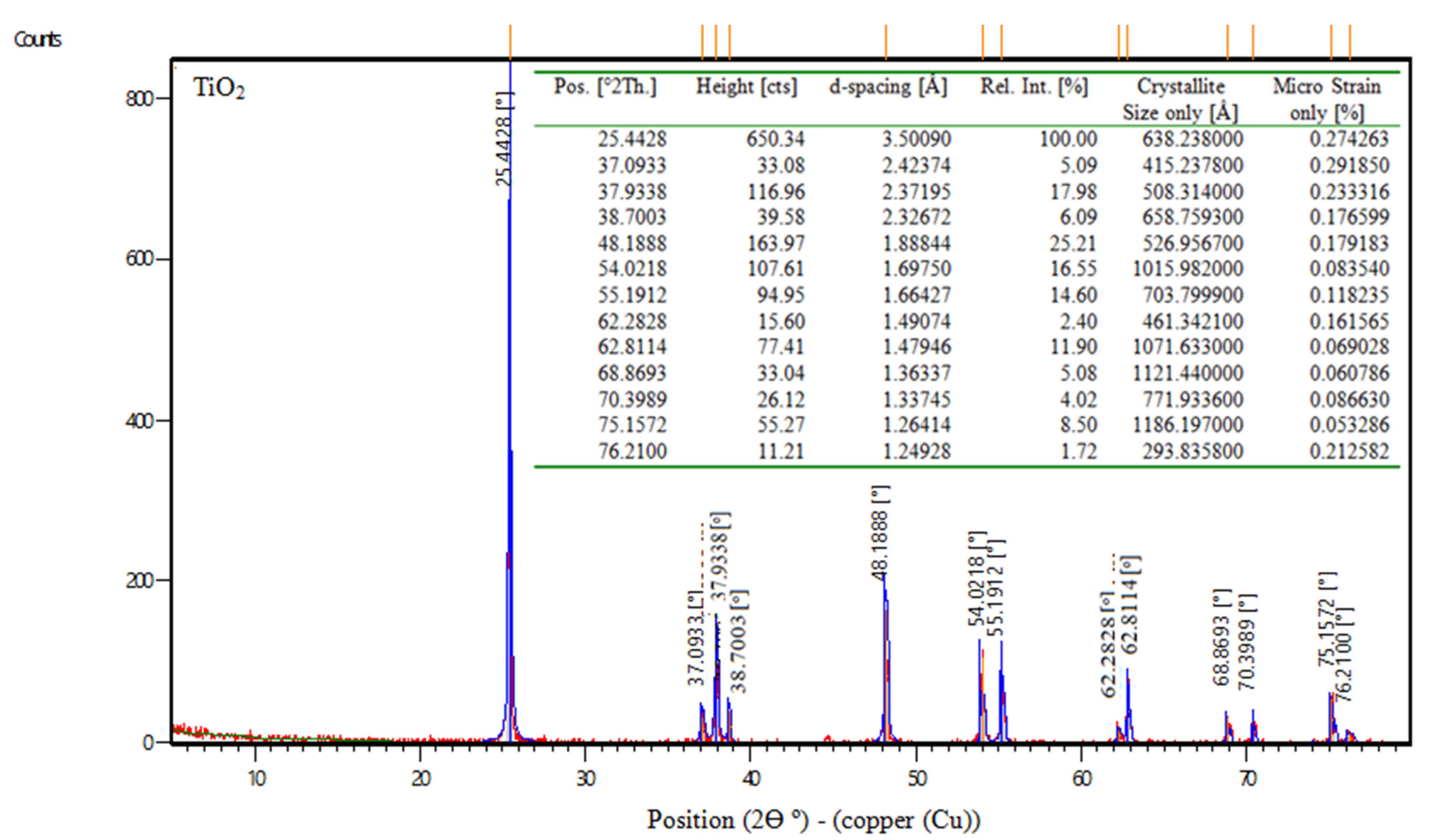
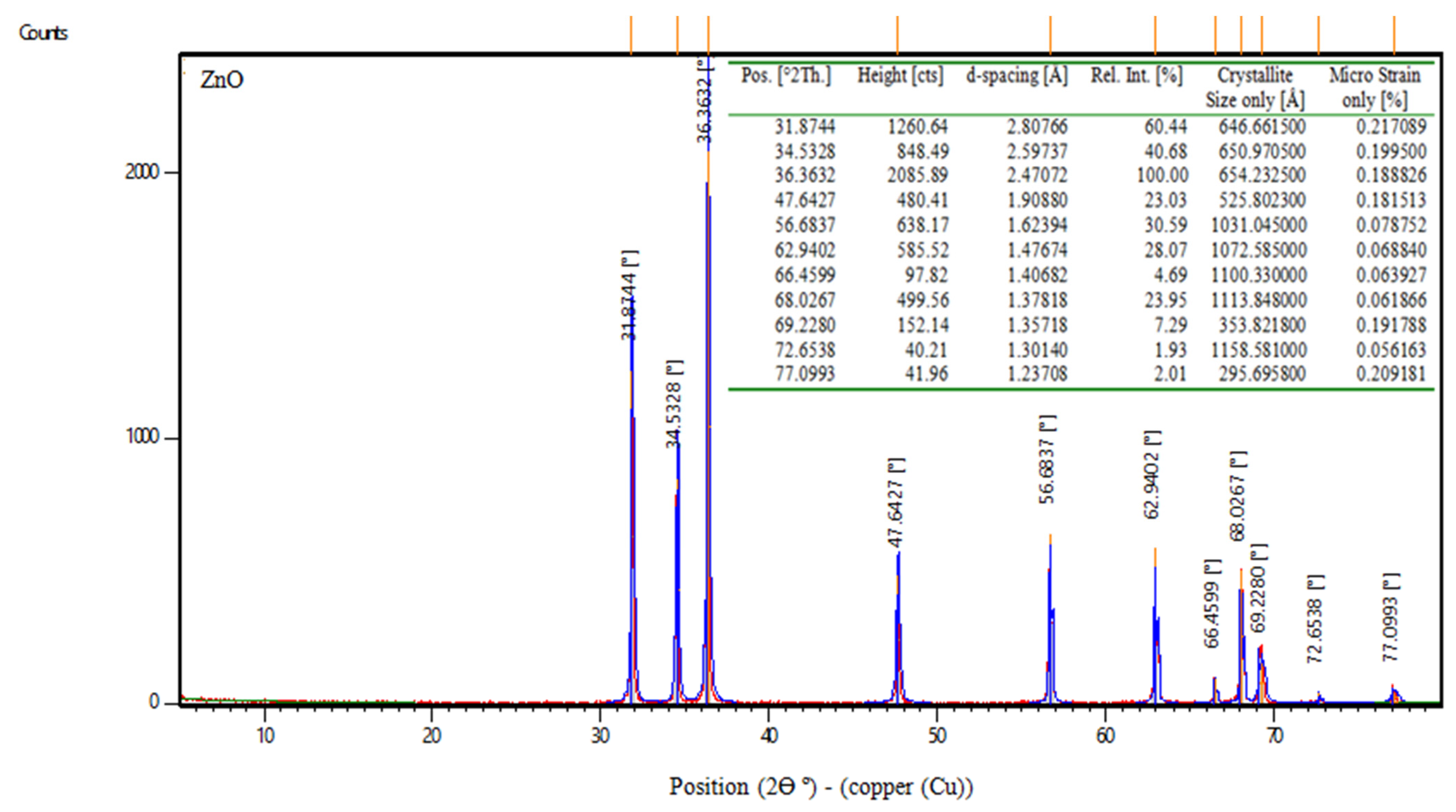
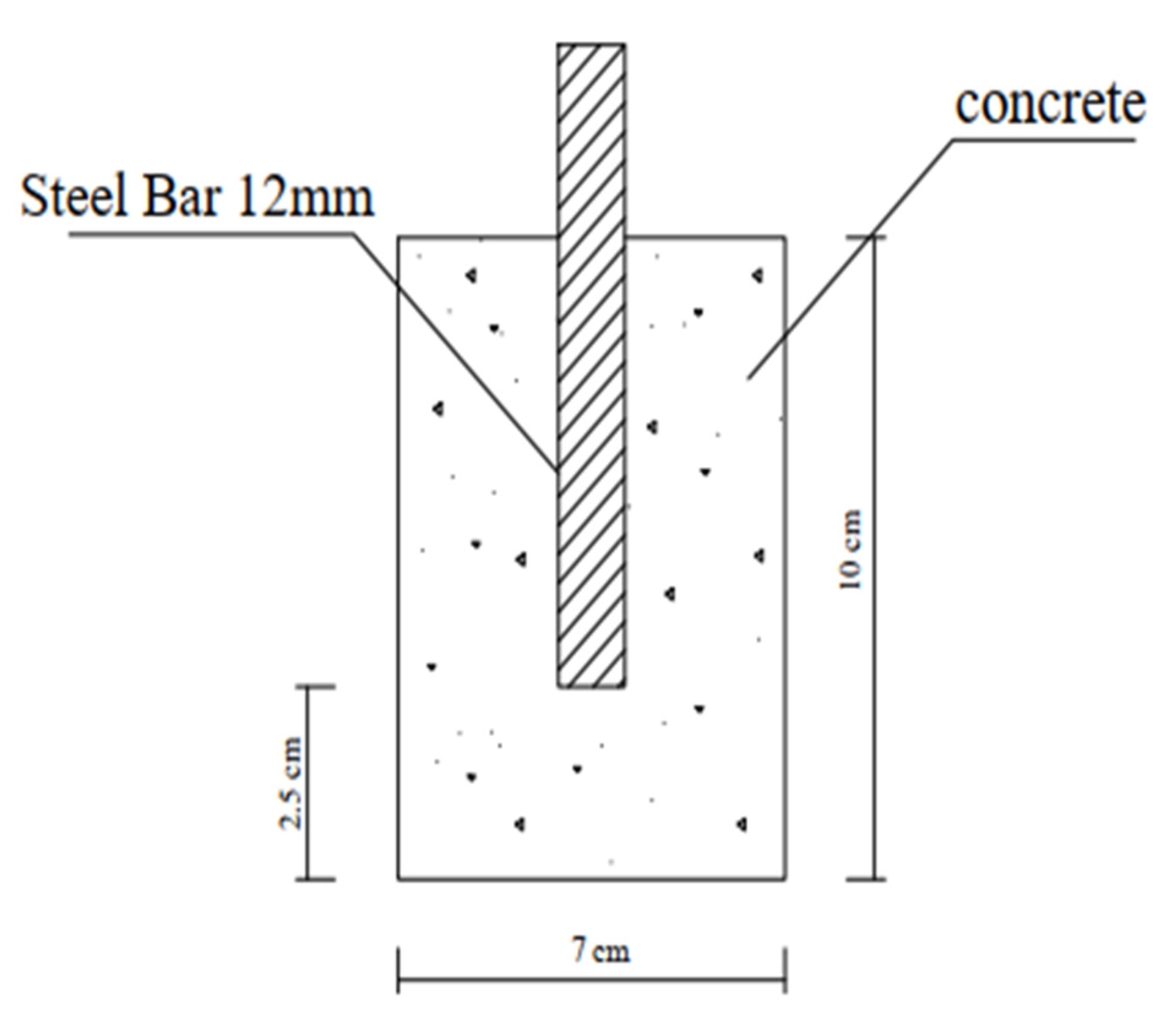
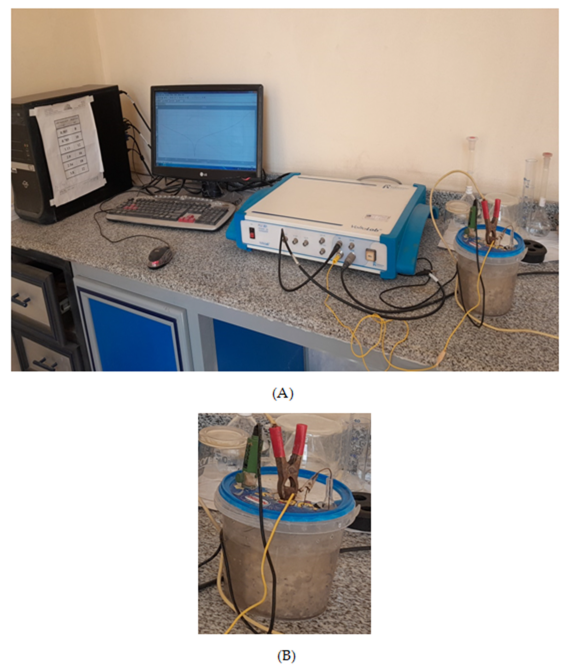
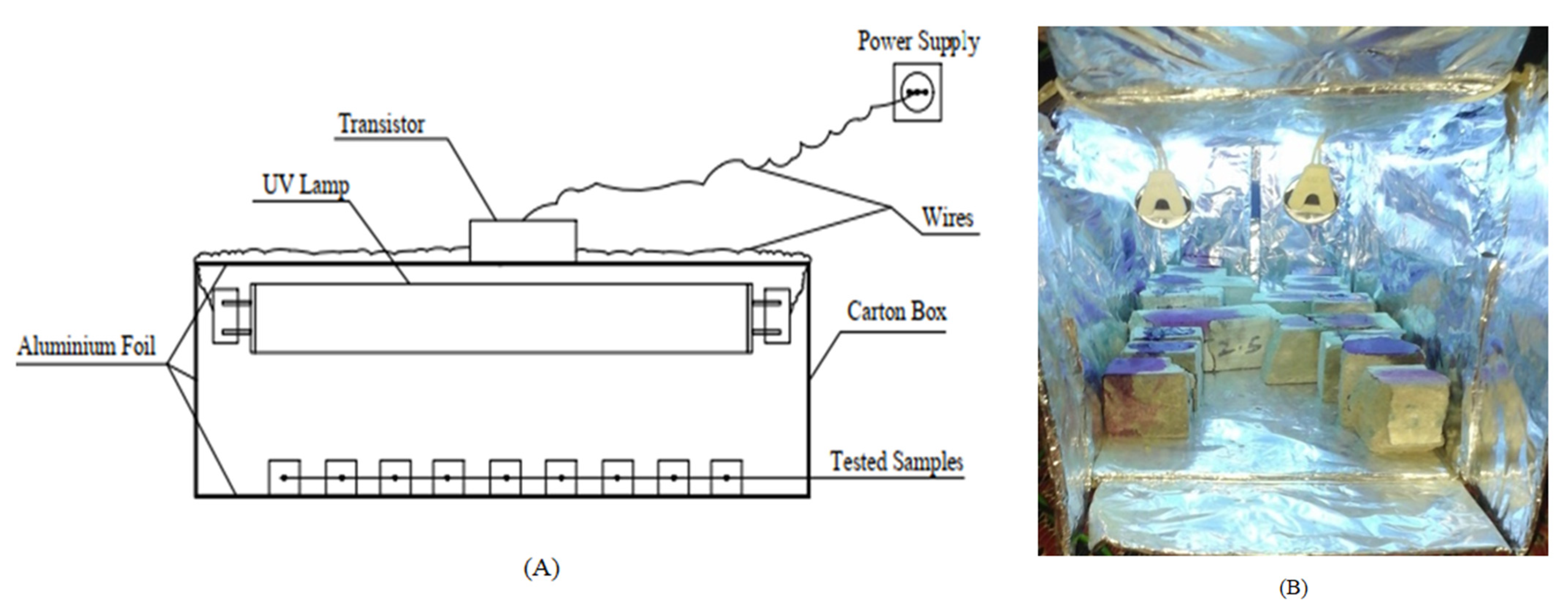
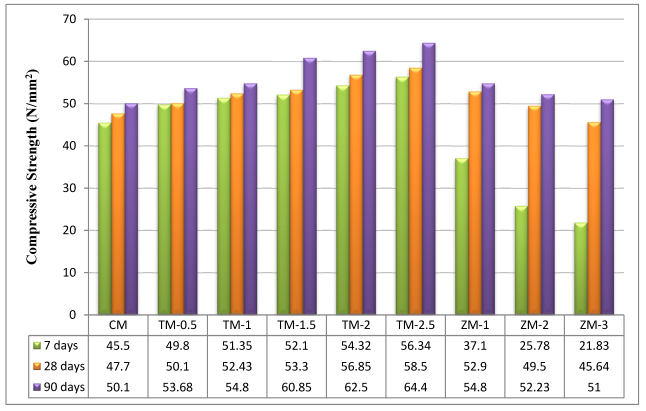
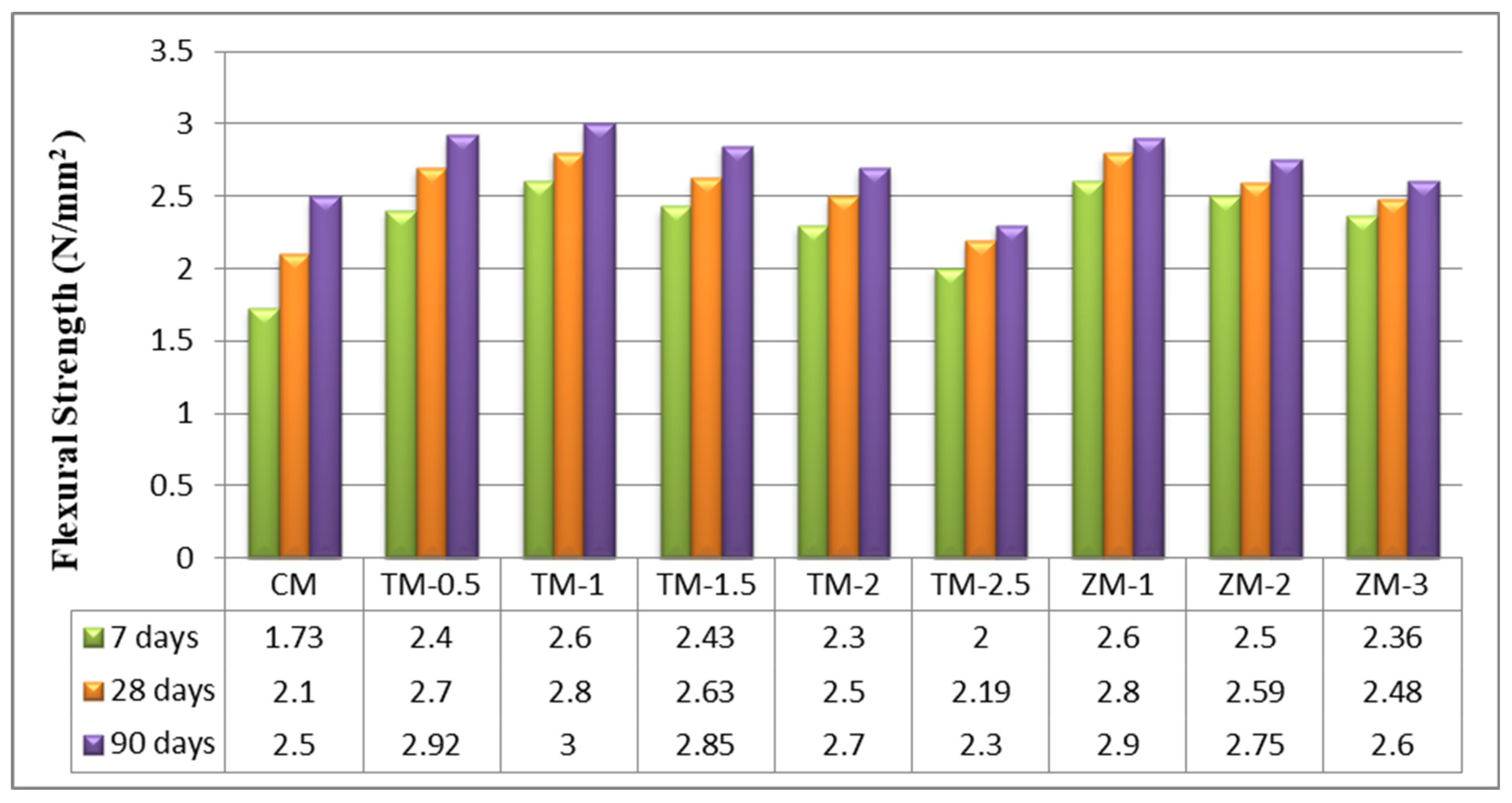
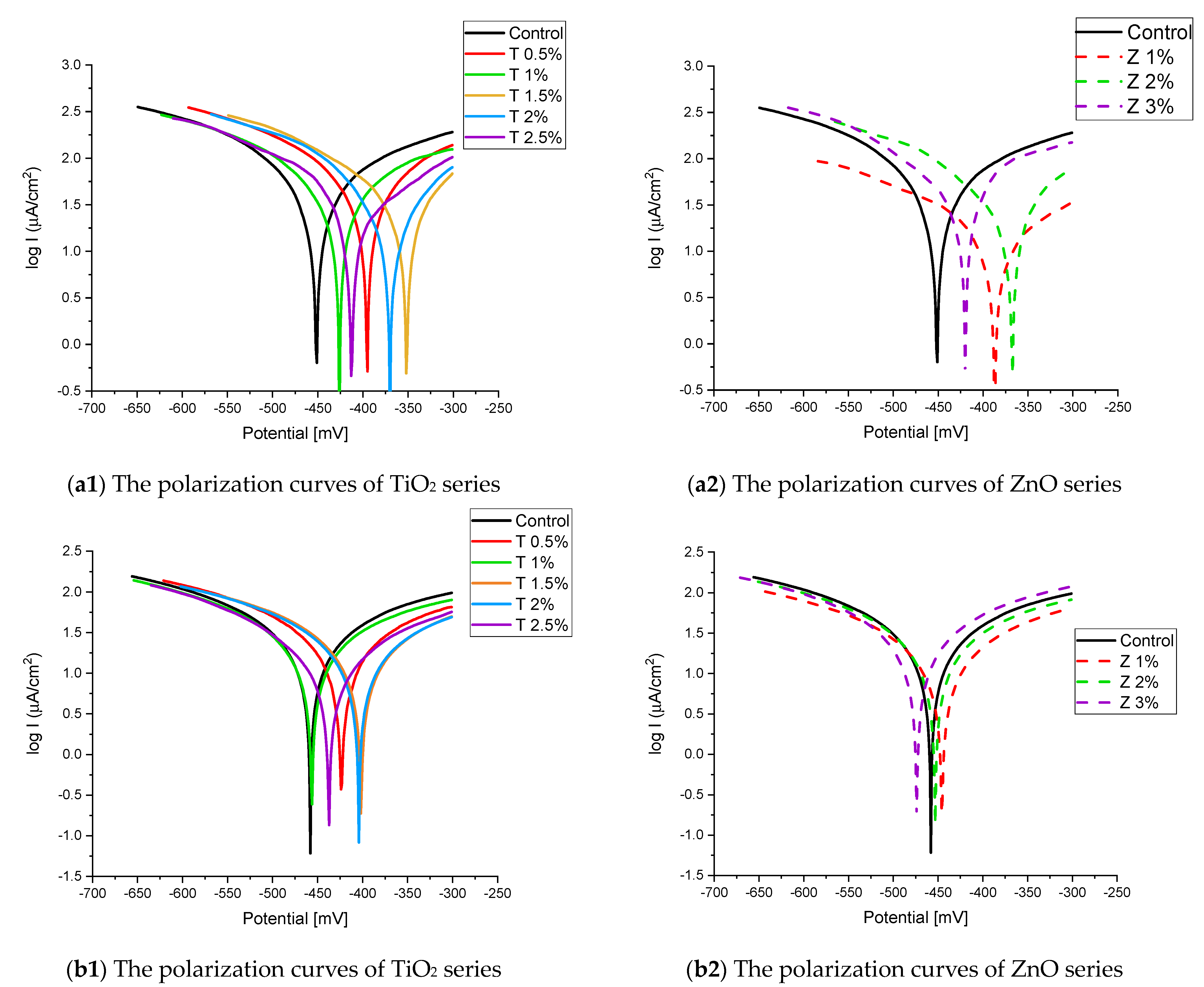
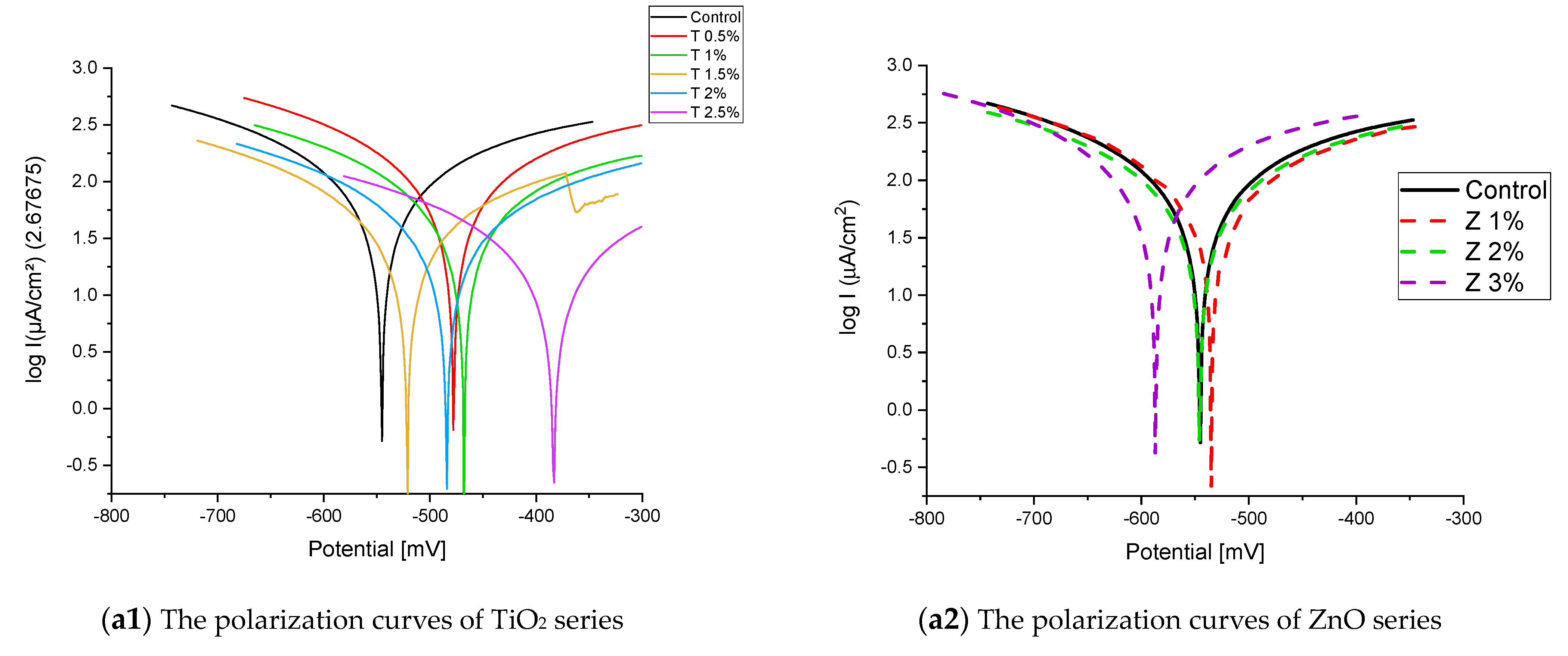
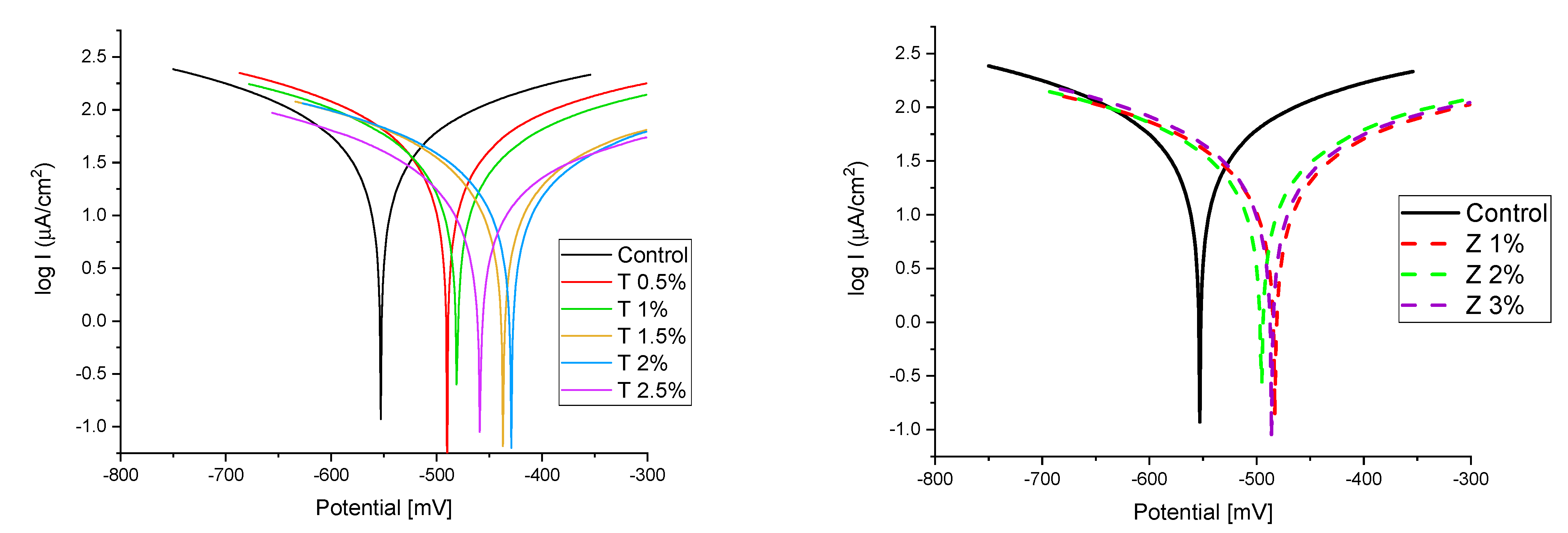
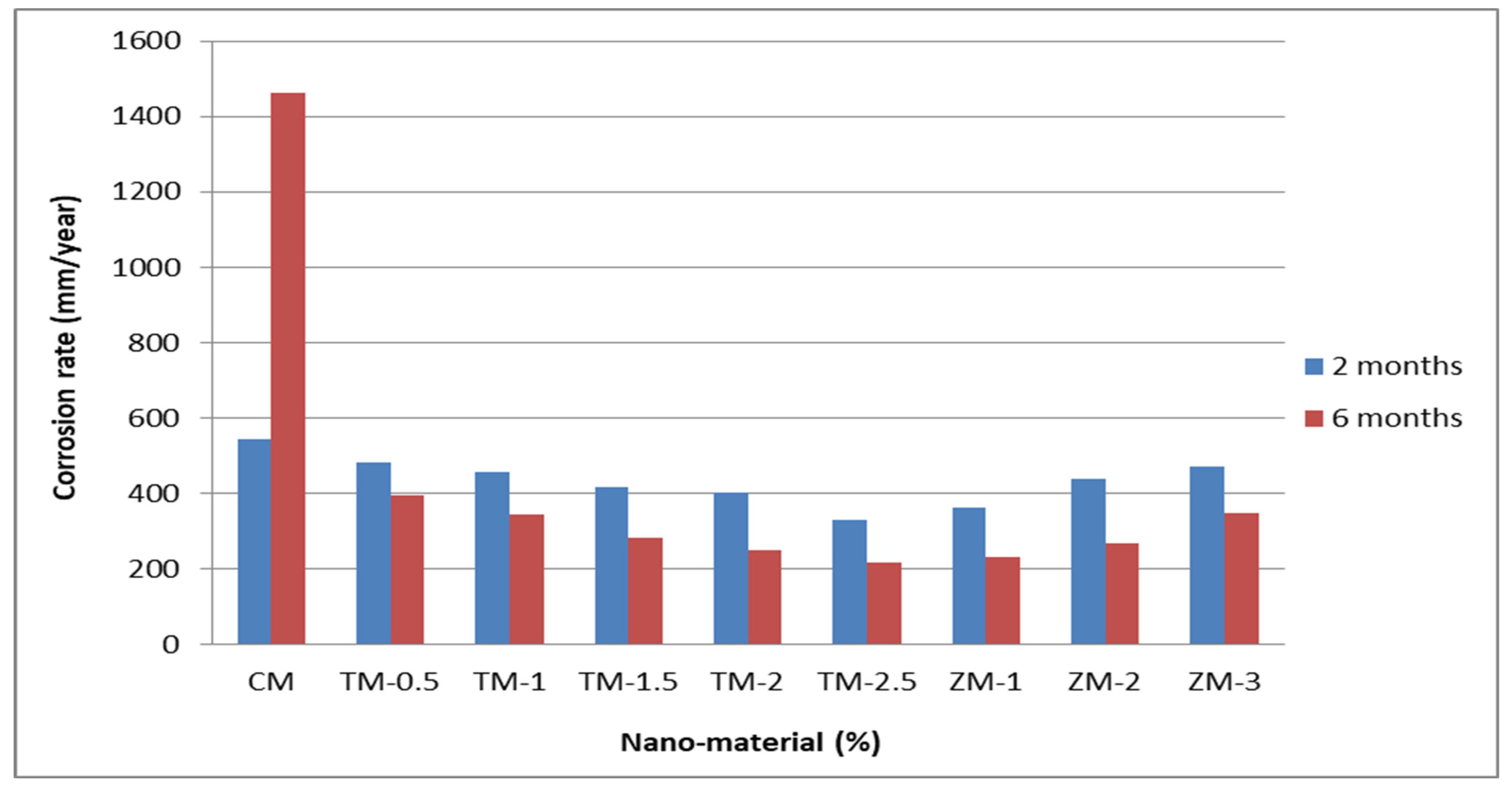

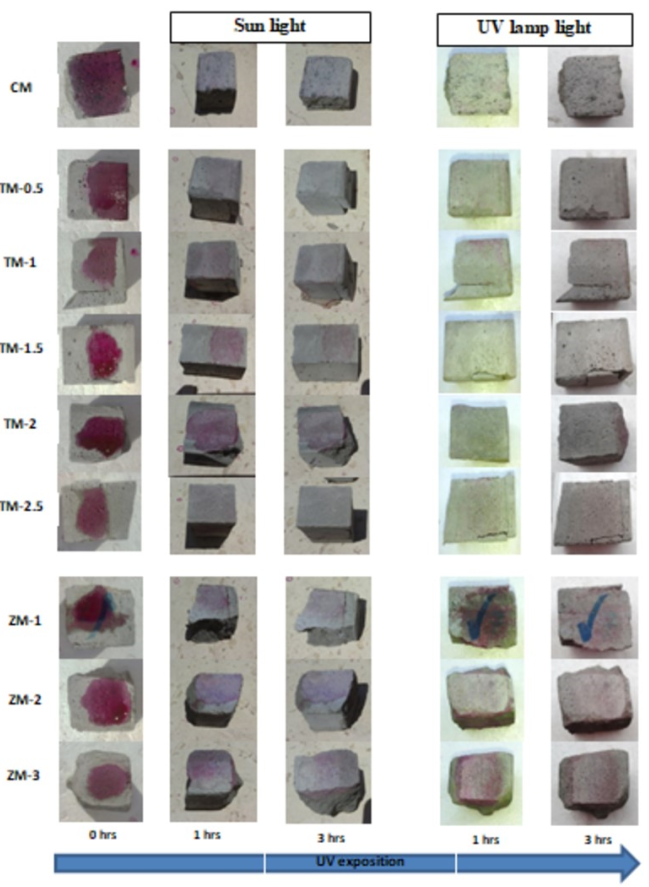
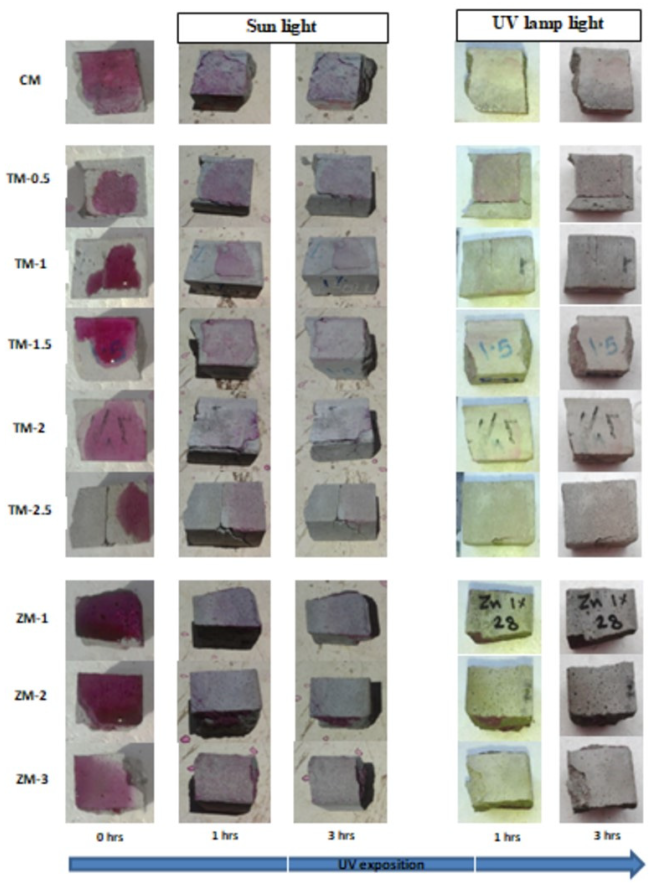

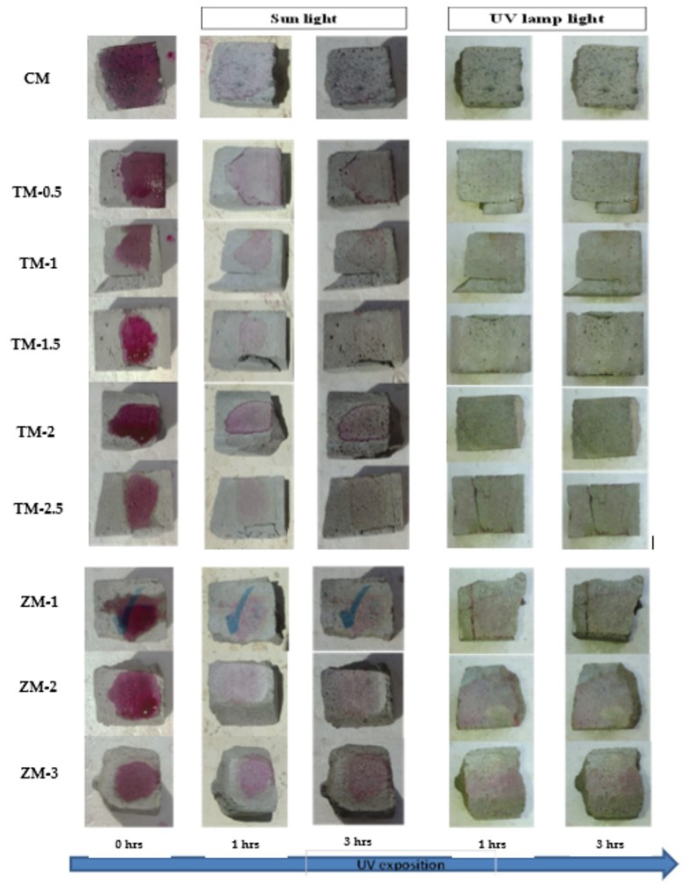
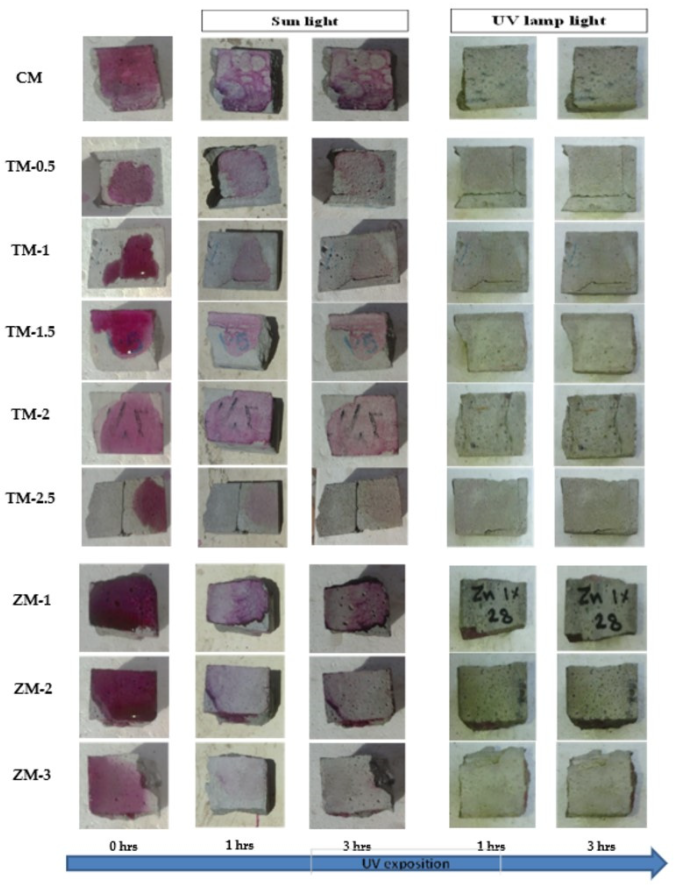
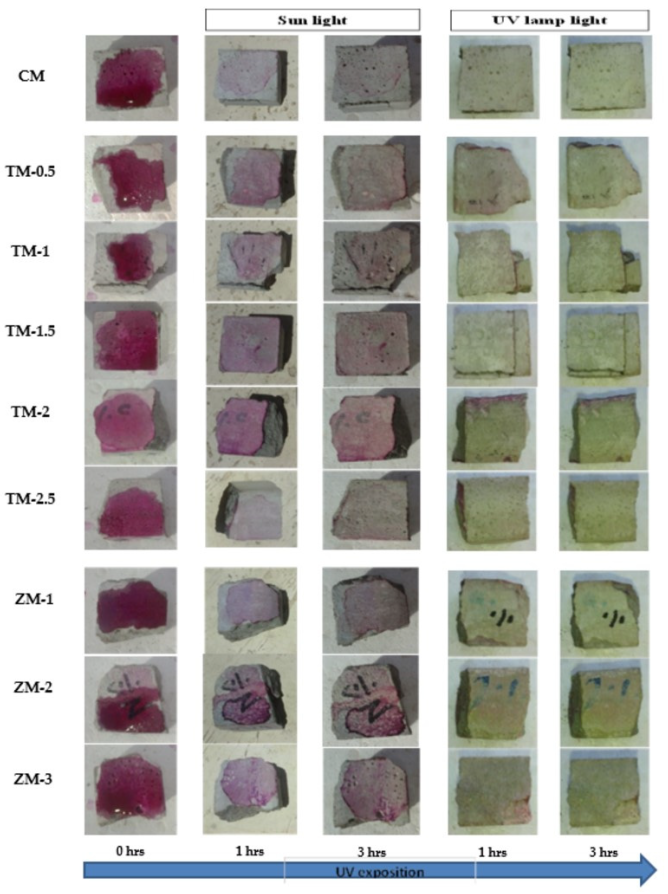
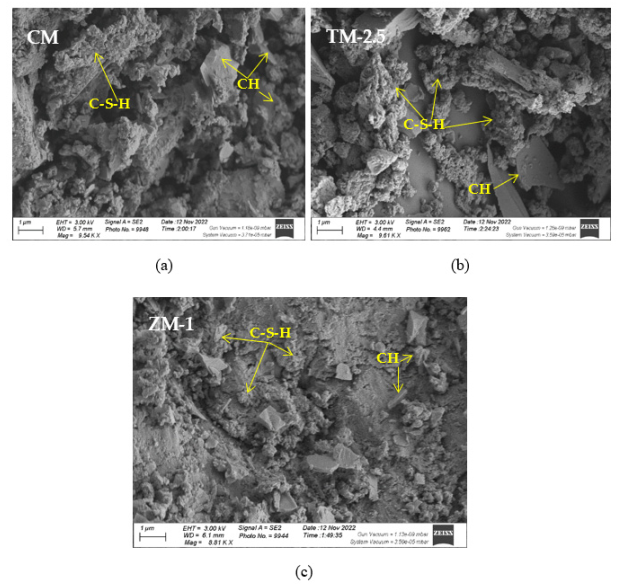
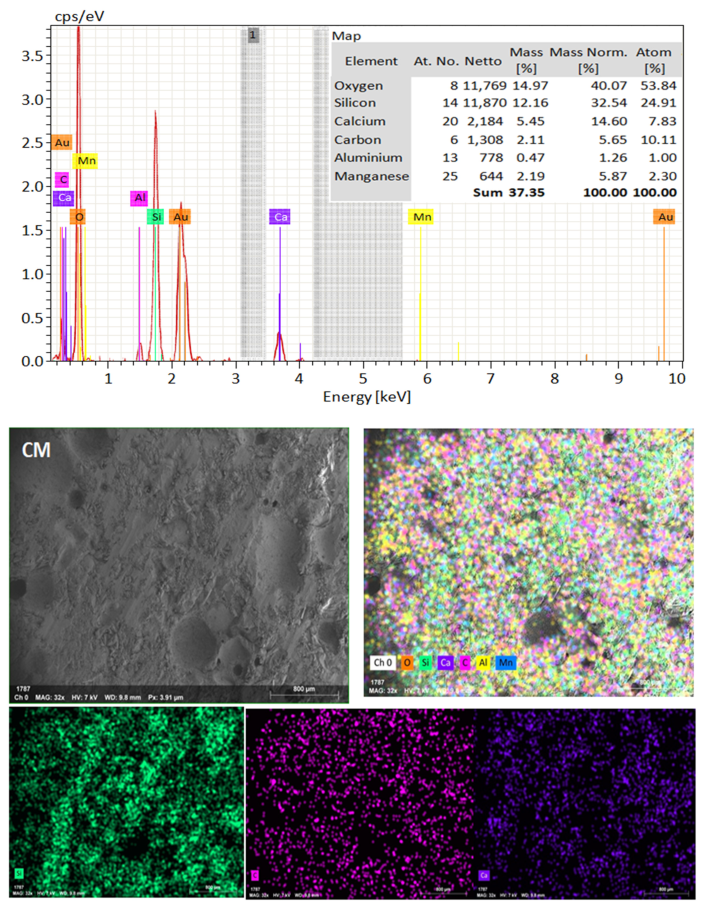

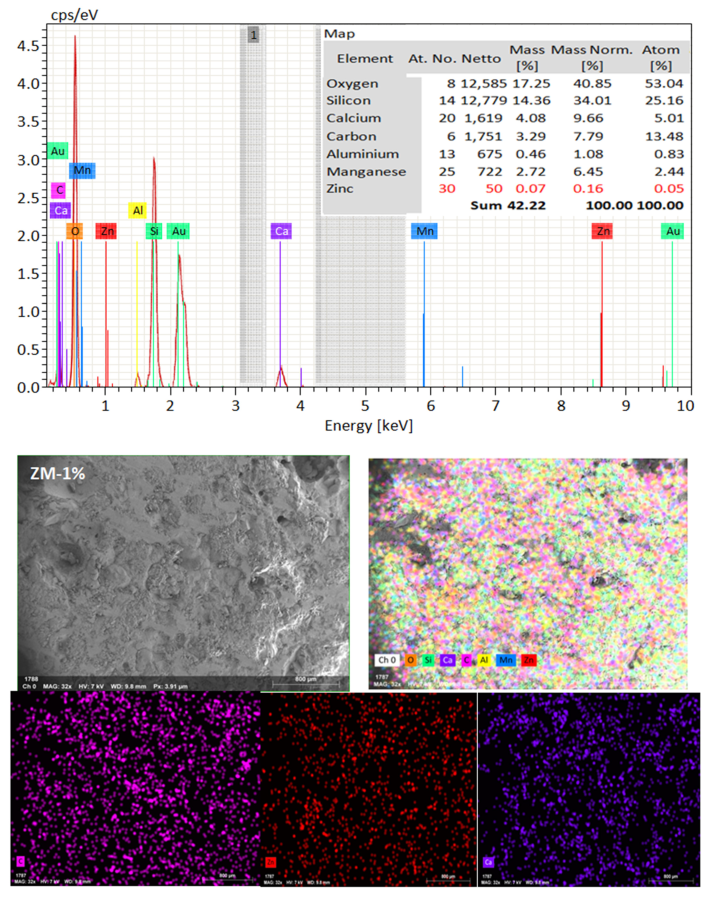
| Material | Fe2O3 | SO3 | SiO2 | MgO | K2O | CaO | Al2O3 | Na2O | LOI | F.L |
|---|---|---|---|---|---|---|---|---|---|---|
| wt% | 3.22 | 2.39 | 21.20 | 0.69 | 0.50 | 63.41 | 5.50 | 0.10 | 2.30 | 2.70 |
| Property | Sand | Crushed Dolomite | Specification Limits |
|---|---|---|---|
| Fineness modulus | 2.35 | 2.20 | 2–2.73 |
| Volume weight (t/m3) | 1.65 | 1.45 | 1.4–1.7 |
| Specific gravity (t/m3) | 2.5 | 2.55 | 2.5–2.7 |
| Material | Chemical Composition (%) | ||||||||||
|---|---|---|---|---|---|---|---|---|---|---|---|
| CaO | K2O | MgO | SiO2 | Al2O3 | Na2O | MnO | SO3 | P2O5 | LOI | Cl | |
| Sand | 0.47 | 0.64 | 0.31 | 91.40 | 3.32 | 0.63 | 0.02 | 0.24 | 0.06 | 1.13 | 0.14 |
| Crushed dolomite | 32.01 | 0.01 | 19.18 | 1.74 | 0.05 | 0.11 | – | – | – | 46.20 | – |
| Property | Results |
|---|---|
| Average particle size (nm) | 25 ± 5 |
| Density (g/cm3) | 4.1 |
| Purity (%) | 99% |
| Color | white |
| Shape | Powder |
| Property | Results |
|---|---|
| Average particle size (nm) | 30 ± 10 |
| Density (g/cm3) | 5.6 |
| Purity (%) | 99% |
| Color | white |
| Shape | Powder |
| Property | Results |
|---|---|
| Density | 1.025 gm/cm3 |
| Sodium | 10.109 gm/L |
| Sulfate | 9.712 gm/L |
| Chlorides | 12.985 gm/L |
| Calcium | 0.500 gm/L |
| Bicarbonate | 0.305 gm/L |
| Carbonates | 0.030 gm/L |
| Magnesium | 1.325 gm/L |
| Soluble salts | 35.438 gm/L |
| Others | 0.472 gm/L |
| Ions | – |
| Base | Naphthalene formaldehyde sulfonate |
| Color | Dark brown liquid |
| Density (at 20 °C) | 1.20 ± 0.005 kg/lit. |
| Chloride content | Free chloride |
| Compatibility | All types of Portland cement, including sulfate resistor cement |
| Specimens | Sand (kg/m3) | Crushed Dolomite (kg/m3) | Cement (kg/m3) | Water (kg/m3) | Super- Plasticizer (%) | nps-TiO2 (%) | nps-ZnO (%) |
|---|---|---|---|---|---|---|---|
| CM * | 596.5 | 1108.10 | 300 | 135 | 1 | - | - |
| CM | 0.4142 | - | 0.1381 | 0.0552 | 1 | - | - |
| TM-0.5 | 0.4142 | - | 0.1381 | 0.0552 | 1 | 0.5 | - |
| TM-1 | 0.4142 | - | 0.1381 | 0.0552 | 1 | 1 | - |
| TM-1.5 | 0.4142 | - | 0.1381 | 0.0552 | 1 | 1.5 | - |
| TM-2 | 0.4142 | - | 0.1381 | 0.0552 | 1 | 2 | - |
| TM-2.5 | 0.4142 | - | 0.1381 | 0.0552 | 1 | 2.5 | - |
| ZM-1 | 0.4142 | - | 0.1381 | 0.0552 | 1 | - | 1 |
| ZM-2 | 0.4142 | - | 0.1381 | 0.0552 | 1 | - | 2 |
| ZM-3 | 0.4142 | - | 0.1381 | 0.0552 | 1 | - | 3 |
| Mix | Crate (mm/Year) at 2 Months | Crate (mm/Year) at 6 Months |
|---|---|---|
| CM | 545 | 1462 |
| TM-0.5 | 483 | 396 |
| TM-1 | 458 | 343 |
| TM-1.5 | 417 | 284 |
| TM-2 | 401 | 250 |
| TM-2.5 | 329 | 218 |
| ZM-1 | 362 | 233 |
| ZM-2 | 437 | 269 |
| ZM-3 | 471 | 347 |
| Mix | Crate (mm/Year) at 2 Months | Crate (mm/Year) at 6 Months |
|---|---|---|
| CM | 958 | 1742 |
| TM-0.5 | 820 | 710 |
| TM-1 | 685 | 608 |
| TM-1.5 | 610.3 | 435 |
| TM-2 | 530 | 420 |
| TM-2.5 | 327 | 306 |
| ZM-1 | 458 | 280 |
| ZM-2 | 642 | 486 |
| ZM-3 | 734 | 531 |
| Mix | Inhibitor Efficiency (ƞ) % | |
|---|---|---|
| Fresh Tap-Water-Cured Specimens | Qaroun’s Lake Water-Cured Specimens | |
| TM-0.5 | 11.38 | 14.41 |
| TM-1 | 15.96 | 28.50 |
| TM-1.5 | 23.49 | 36.29 |
| TM-2 | 26.42 | 44.68 |
| TM-2.5 | 39.63 | 65.87 |
| Mix | Inhibitor Efficiency (ƞ) % | |
|---|---|---|
| Fresh Tap-Water-Cured Specimens | Qaroun’s Lake Water-Cured Specimens | |
| ZM-1 | 33.58 | 52.19 |
| ZM-2 | 19.82 | 32.99 |
| ZM-3 | 13.58 | 23.38 |
| Mix | Inhibitor Efficiency (ƞ) % | |
|---|---|---|
| Fresh Tap-Water-Cured Specimens | Qaroun’s Lake Water-Cured Specimens | |
| TM-0.5 | 72.91 | 59.24 |
| TM-1 | 76.54 | 65.10 |
| TM-1.5 | 80.57 | 75.03 |
| TM-2 | 82.90 | 75.89 |
| TM-2.5 | 85.09 | 82.43 |
| Mix | Inhibitor Efficiency (ƞ) % | |
|---|---|---|
| Fresh Tap-Water-Cured Specimens | Qaroun’s Lake Water-Cured Specimens | |
| ZM-1 | 84.06 | 83.93 |
| ZM-2 | 81.60 | 72.10 |
| ZM-3 | 76.27 | 69.52 |
Disclaimer/Publisher’s Note: The statements, opinions and data contained in all publications are solely those of the individual author(s) and contributor(s) and not of MDPI and/or the editor(s). MDPI and/or the editor(s) disclaim responsibility for any injury to people or property resulting from any ideas, methods, instructions or products referred to in the content. |
© 2023 by the authors. Licensee MDPI, Basel, Switzerland. This article is an open access article distributed under the terms and conditions of the Creative Commons Attribution (CC BY) license (https://creativecommons.org/licenses/by/4.0/).
Share and Cite
Mostafa, F.E.-Z.M.; Smarzewski, P.; El Hafez, G.M.A.; Farghali, A.A.; Morsi, W.M.; Faried, A.S.; Tawfik, T.A. Analyzing the Effects of Nano-Titanium Dioxide and Nano-Zinc Oxide Nanoparticles on the Mechanical and Durability Properties of Self-Cleaning Concrete. Materials 2023, 16, 6909. https://doi.org/10.3390/ma16216909
Mostafa FE-ZM, Smarzewski P, El Hafez GMA, Farghali AA, Morsi WM, Faried AS, Tawfik TA. Analyzing the Effects of Nano-Titanium Dioxide and Nano-Zinc Oxide Nanoparticles on the Mechanical and Durability Properties of Self-Cleaning Concrete. Materials. 2023; 16(21):6909. https://doi.org/10.3390/ma16216909
Chicago/Turabian StyleMostafa, Fatma El-Zahraa M., Piotr Smarzewski, Ghada M. Abd El Hafez, Ahmed A. Farghali, Wafaa M. Morsi, Ahmed S. Faried, and Taher A. Tawfik. 2023. "Analyzing the Effects of Nano-Titanium Dioxide and Nano-Zinc Oxide Nanoparticles on the Mechanical and Durability Properties of Self-Cleaning Concrete" Materials 16, no. 21: 6909. https://doi.org/10.3390/ma16216909
APA StyleMostafa, F. E.-Z. M., Smarzewski, P., El Hafez, G. M. A., Farghali, A. A., Morsi, W. M., Faried, A. S., & Tawfik, T. A. (2023). Analyzing the Effects of Nano-Titanium Dioxide and Nano-Zinc Oxide Nanoparticles on the Mechanical and Durability Properties of Self-Cleaning Concrete. Materials, 16(21), 6909. https://doi.org/10.3390/ma16216909








